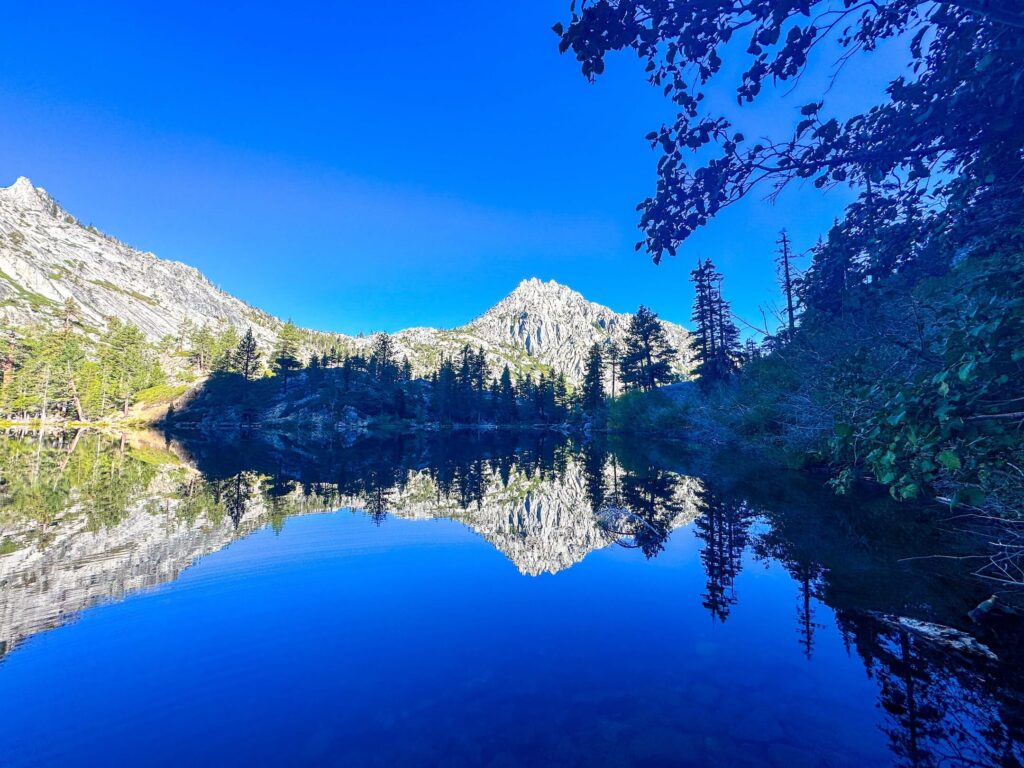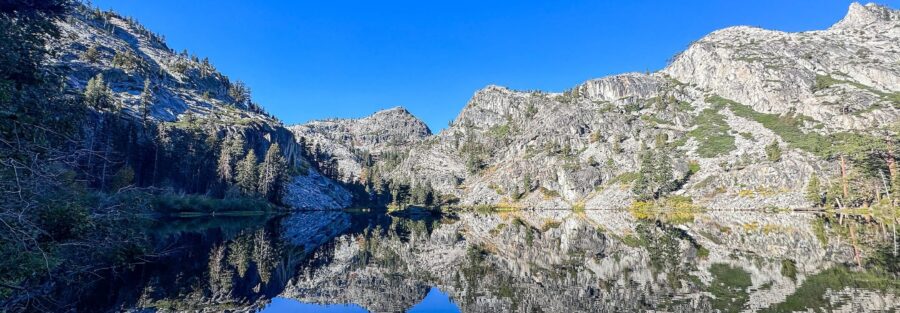Quick Facts:
Location: South Lake Tahoe, California
Coordinates: 38.95195839280451, -120.11321961671531
Length: 2 Miles
Difficulty: Moderate
Elevation Gain: 400’
Dog Friendly: Yes
Introduction:
Eagle Lake, located in the Desolation Wilderness near Lake Tahoe, California, is one of the most popular and stunning hikes in the area. Offering a serene mountain lake surrounded by granite peaks, it’s an ideal destination for anyone seeking a short, scenic hike with rewarding views. Whether you’re a seasoned hiker or just looking for a peaceful day out in nature, Eagle Lake provides an accessible and beautiful escape. In this guide, we’ll cover all you need to know, from how to get there and what to expect on the trail, to nearby attractions and the best time to visit.
How to Get There:
Eagle Lake is located on the southwestern shore of Lake Tahoe, in the El Dorado National Forest. To reach the trailhead, drive along Highway 89 from South Lake Tahoe, heading north toward Emerald Bay. The trailhead is located just past the Eagle Falls Picnic Area, about 9 miles from South Lake Tahoe. It’s easy to spot, as it shares the parking area with the popular Eagle Falls Trail. For those coming from the Tahoe City side, simply follow Highway 89 south around Emerald Bay until you see signs for Eagle Falls.
Parking Information:
Parking for the Eagle Lake Trail is available at the Eagle Falls parking lot. It’s a paid parking area, managed by the U.S. Forest Service, and the fee is around $5 per vehicle. If you have an America the Beautiful pass or a Tahoe Basin annual pass, you can park for free, but remember to display the pass clearly on your dashboard.

The Scenic Landscape:
As you ascend, the trail opens up to reveal sweeping views of Emerald Bay and Lake Tahoe in the distance. The contrast between the deep blue of the lake and the jagged granite cliffs is breathtaking. After a moderate climb through a forested area of towering pines and firs, you’ll reach Eagle Lake, a pristine alpine lake located in a granite bowl. Surrounded by rocky peaks and lush greenery, the lake offers a serene setting that feels worlds away from the bustling Lake Tahoe shoreline.
Eagle Lake is small but incredibly stunning, and it’s easy to find a spot along the shore to sit and take in the natural beauty. The clear water reflects the surrounding granite cliffs, creating a postcard worthy scene. During the summer, you’ll often see hikers taking a refreshing dip in the lake, though the water stays cold year-round.
Trail Difficulty and Length:
The Eagle Lake Trail is considered moderate in difficulty and is suitable for hikers of most skill levels. The round trip distance is about 2 miles, making it a relatively short hike, but the elevation gain of around 400 feet adds some challenge. The trail is well maintained and easy to follow, though there are a few rocky sections that require careful footing. Hiking shoes with good grip are recommended, especially if you’re hiking after rain or early in the season when snowmelt can make parts of the trail wet or slippery.

Is Eagle Lake Dog Friendly?
Yes, the Eagle Lake Trail is dog friendly, and many hikers choose to bring their furry companions along for the adventure. Dogs must be kept on a leash at all times, as the area is part of the Desolation Wilderness, where wildlife is abundant. The trail’s relatively short distance and moderate incline make it manageable for most dogs, but be sure to bring plenty of water for both you and your dog, as there are no reliable water sources along the way until you reach the lake.
Local Regulations and Guidelines:
Eagle Lake is located within the Desolation Wilderness, which is a protected area, so it’s essential to follow local regulations and Leave No Trace principles. This includes packing out all trash, respecting wildlife, and staying on designated trails to prevent erosion and protect the fragile alpine environment. Since this is a wilderness area, day hikers are required to fill out a free wilderness permit, which can be obtained at the trailhead. The permit system helps to monitor trail use and protect the area’s natural resources.
Fires and camping are prohibited around Eagle Lake, but there are designated campsites in other areas of the Desolation Wilderness for those looking to spend more time in the backcountry. If you plan to camp in the wilderness, you’ll need a separate overnight permit.
Other Trails Nearby:
For those looking to extend their hiking experience, several other trails in the area offer additional exploration. The Eagle Falls Trail continues beyond Eagle Lake, leading deeper into the Desolation Wilderness toward Velma Lakes and Dicks Pass, providing more challenging options for seasoned hikers. These trails offer opportunities for longer day hikes or multi-day backpacking trips, with more stunning alpine lakes and vistas along the way.
The nearby Bayview Trailhead, located just down the road, also offers access to the Desolation Wilderness and leads to several other scenic spots, including Granite Lake and Maggie’s Peak. These trails are a bit more challenging but equally rewarding for those looking for more adventure.

Non-Hiking Attractions Nearby:
Once you’ve finished your hike, there are plenty of non-hiking activities to enjoy in the surrounding area. Just a short drive from the trailhead is Emerald Bay State Park, home to the famous Vikingsholm Castle, a stunning example of Scandinavian architecture. You can take a guided tour of the castle or simply enjoy a relaxing day on the beach at Emerald Bay.
For those interested in water sports, South Lake Tahoe offers a variety of options, including kayaking, paddleboarding, and boat tours that provide a unique perspective of the lake. The beaches along the south shore, including Baldwin Beach and Pope Beach, are perfect for swimming and picnicking, offering sandy shores and calm waters ideal for families.
If you’re looking for a cultural experience, Tallac Historic Site, located near the southern end of Lake Tahoe, offers a glimpse into the area’s past with beautifully preserved estates and gardens. It’s a great place to take a leisurely stroll after your hike or learn more about Tahoe’s history.
Accommodations: Where To Set Up Basecamp
For classic casino action with a mountain backdrop, Harrah’s Lake Tahoe is the place to be. With spacious rooms, plenty of dining options, and nightlife right on site, this resort makes it easy to keep the fun rolling from sunrise to well past midnight.
👉Book your stay at Harrah’s Lake Tahoe today and get in on the action.
If lake views and relaxation are calling your name, Hotel Azure Tahoe is the perfect choice. Located right across from the water, it offers cozy rooms, family-friendly amenities, and easy access to South Lake Tahoe’s dining and shops. It’s the kind of spot where you can slow down and soak it all in.
👉Reserve your room at Hotel Azure Tahoe now and enjoy lakeside comfort.
Modern, lively, and packed with amenities, Bally’s Lake Tahoe delivers a fun mix of casino energy and resort-style comfort. From its updated rooms and indoor pool to the spa and on-site dining, it’s a solid pick whether you’re here for gaming, a getaway, or both.
👉Click here to book your stay at Bally’s Lake Tahoe and experience it all.
Best Time to Visit:
The best time to hike Eagle Lake is from late spring to early fall. In the spring, the trail is especially beautiful, as Eagle Falls is fed by melting snow, and the surrounding greenery comes to life. Early summer is an ideal time to visit, as wildflowers bloom along the trail, and the weather is mild. However, this is also the busiest time of year, so visiting on a weekday or early in the morning can help you avoid the crowds.
Fall is another fantastic time to visit, with cooler temperatures and stunning fall colors adding to the beauty of the hike. The trail tends to be less crowded in the fall, providing a more peaceful experience.
Support the Adventure
To make your walls less boring, check out my photography portfolio and bring a piece of the wild and my story into your home.
If you’d like to fuel future adventures, you can donate a coffee on Ko-Fi. Every cup keeps me chasing sunrises and stories.
When you shop using my affiliate links, every click helps support this blog at no extra cost to you. It’s a small way to keep Unicorn Adventure alive and kicking while I keep exploring.
Subscribe to my mailing list for future updates, new stories, and behind-the-scenes adventures.
Stay connected with me on Instagram and Facebook for more photos and daily inspiration.
Thanks for being part of the journey, Unicorn Squadron!


